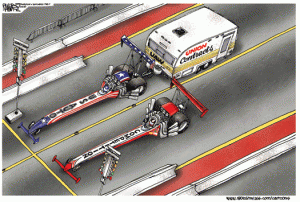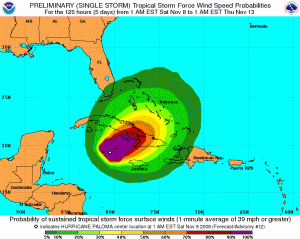UPDATE: There is a better discussion of what happened here and some analysis that is right on.
Many put the blame for the attack on years of Indian-Pakistani hostility and tension. In fact, relations between the two countries have never been warmer. This past month, Pakistan’s new president stunned and delighted Indians by publicly renouncing any first use of nuclear weapons. Violence in Kashmir, the principal bone of contention between India and Pakistan since 1947, is on the decline. Before the Mumbai attacks, politicians were scheduled to start talks on permitting trade across the region’s Line of Control, so that Hindu farmers in Indian Kashmir can sell their wheat or a used tractor to Muslim farmers in Pakistani Kashmir.
Thus, the purported motivation for terrorist attacks is bogus.
India’s record on counterterrorism is abysmal, almost deliberately so. The government in New Delhi steadfastly maintains a wall of separation between law-enforcement agencies like the one that used to separate the FBI and CIA before the Patriot Act, and keeps counterterrorist units underfunded and undermanned. It has repeatedly given way to the demands of Islamic radical groups and fundamentalist lobbyists in the name of “cultural sensitivity.” India was the first non-Islamic country to ban Salman Rushdie’s Satanic Verses back in 1988.
India has no preventive detention laws; no laws to protect the identity of anti-terrorist witnesses; and no laws to allow domestic wiretapping without court order. In 2004, the new Congress Party government revoked India’s version of the Patriot Act, even as the Indian media was loudly condemning the U.S. for “torture” at Gitmo and Abu Ghraib.
In short, the Indian government has waged the war on terror in much the same way that liberals and many Democrats have been urging the U.S. to carry it out. The result is that more than 4,000 Indians have died in attacks since 2004 — more than any other nation in the war on terror besides Iraq.
I wonder of Obama is digesting this information. His ability to learn, since he begins at such a low information level about anything except running for office, is critical for our safety.
The Washington Post has a mildly interesting account of the terrorist attack in Mumbai. Far more interesting and informative (as usual) are Indian blog accounts with details missing from mainstream media stories. Even cricket blogs have covered the events, and in more detail than US media. Indian newspapers seem to be more willing to criticize politicians, although Indian politicians might even be worse then ours, if that is possible considering the Vice-President-elect.
The police told the Cabinet that the terrorists had arrived in the city in a boat from Karachi. The boat had stopped four nautical miles short of the Mumbai coast. Two hovercraft hired by someone for the terrorists ferried them to the jetty near Colaba.
The government machinery, taken completely by surprise by the terror attack, decided to call in the Army at 11 pm on Wednesday. After frantic calls to Delhi, senior Mantralaya officials requested National Security Guards (NSG) Commandos for the operation. Calls also went to Chief Minister Vilasrao Deshmukh, who was in Kerala.
Deputy CM R R Patil, who was supervising the operation from his official residence at Malabar Hill, was requested by PWD Minister Chhagan Bhujbal to visit the DGP office at Colaba.
Sources said though the plane carrying NSG Commandos was ready by midnight, it could not take off due to the delayed arrival of a VIP, who wanted to accompany them to Mumbai, at the Delhi airport. Worse, the Commandos had to wait for a vehicle at the Mumbai airport until morning.
As I wrote, even worse politicians than ours. The Indians have captured one of the vessels that ferried the terrorists ashore so that may be a lead to local cooperation.
Indian television seems to be no more responsible than our own.
Commandos are landing on the Nariman Building. They seem to be tip-toeing down. They are communicating to each other through hand signals. Secrecy & surprise are paramount. And NDTV is showing this live!!! With informative commentary on how many commandos have landed and so on. Perhaps NDTV’s research has shown that terrorists only watch cartoon network during missions.
As long as we are threatened by terrorists, we will remain in a state of suspended war, and we need to invest in bringing our cops up to date with urban warfare, in terms of both training and equipment.
It even brings up an interesting question.
One of my friends mentioned in an email that perhaps our security forces should ask themselves one question when they are faced with such situations: “WWID:
What Would Israelis Do?” The Jerusalem Post had some criticism, but of course Israelis were a target of the terrorists.
There is plenty of criticism although it is early but India seems willing to learn and to act when others are often indecisive. Their weak spot, as is ours, seems to be politicians. The Indian news media was fascinated with the exploits of US Armor officer Neil Prakesh, who joined the US Army after graduation from Johns Hopkins and ROTC training, and led a tank platoon into Fallujah in 2004. The Indian Army is professional and the populations seems supportive of them.
India’s leaders — who invariably swan around with armed guards paid for by the taxpayer — can’t even agree on a legal framework to keep the country safe. On taking office in 2004, one of the first acts of the ruling Congress Party was to scrap a federal antiterrorism law that strengthened witness protection and enhanced police powers.
The Congress Party has stalled similar state-level legislation in Gujarat, which is ruled by the opposition Hindu-nationalist Bharatiya Janata Party. And it was a Congress government that kowtowed to fundamentalist pressure and made India the first country to ban Mumbai-born Salman Rushdie’s “Satanic Verses” in 1988.
The BJP hasn’t exactly distinguished itself either. In 1999, the hijacking of an Indian aircraft to then Taliban-ruled Afghanistan led a BJP government to release three hardened militants, including Omar Sheikh Saeed, the former London School of Economics student who would go on to murder Wall Street Journal reporter Daniel Pearl.
They may have had enough damage inflicted this time to convince the government that it is time to get professional about terrorism. Finally, definite lessons have been shown to be essential to learn.
First, it is utterly and completely bizarre that while we whine about the Home Ministry, the intelligence establishment gets off scot-free even as Indians are murdered on the streets.
It is impossible for the police to guard every building or check every passenger. All over the world, terrorism is fought through intelligence. A good security service penetrates terrorist cells, monitors radio traffic and picks up intelligence about terrorist activity.
Of course, George W Bush is still getting criticism for his efforts to accomplish this essential goal.
Second, we should recognise that there is a new dimension to these attacks that was missing from earlier terrorist strikes. The aim of the Bombay terrorists was to continue the global jihad on Indian soil. That’s why they sought out American and British passport holders and that’s why Israelis and Jews were among the principal targets of the violence.
India is now a first world country and it is therefore a target of the 7th century militants.
Third, L.K. Advani was right when he said that these attacks were not like the usual bombings, but he was wrong when he drew a parallel with the 1993 Bombay blasts.
When we saw the television pictures of the Taj Mahal hotel in flames, it was not the 1993 blasts we thought of. It was 9/11.
It sounds flip and glib to say that these attacks constitute India’s 9/11. But that, in fact, is the truth.
The significance of 9/11 was that it made Americans conscious of the danger they were in and aware that nothing was safe; that terrorists could destroy such powerful symbols of American prestige as the World Trade Center.
I should correct this to assert that some Americans still deny the danger but, since their candidate is now in power and responsible for failure, some of them may change.
It is now reported that British subjects were among the terrorists targeting British passport holders.




